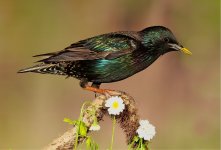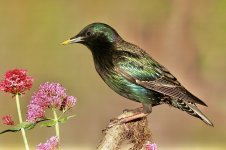I spent a good part of today pursuing my quest to capture the iridescent plumage of the starling.
I think that the secret lies in the angle of the flash units in relation to the lens axis. I remember from my school days that “the angle of incidence is equal to the angle of reflection”. So, if I keep the flash very close to the camera, then the light from the flash is more likely to bounce back into the lens.
It did, however, introduce another problem - steel eye. This is the bird photography equivalent to red eye, where a flash mounted directly on the camera reflects off the back of the eye. The answer is simple - just move the flash further away from the camera! Why is it that in photography, we are always having to balance different parameters and can never choose one without affecting another?
Anyway, I did get it to work and was amazed at just how much iridescence there is to see under the appropriate lighting conditions.
Here are a couple of photos to show the effect.

I think that the secret lies in the angle of the flash units in relation to the lens axis. I remember from my school days that “the angle of incidence is equal to the angle of reflection”. So, if I keep the flash very close to the camera, then the light from the flash is more likely to bounce back into the lens.
It did, however, introduce another problem - steel eye. This is the bird photography equivalent to red eye, where a flash mounted directly on the camera reflects off the back of the eye. The answer is simple - just move the flash further away from the camera! Why is it that in photography, we are always having to balance different parameters and can never choose one without affecting another?
Anyway, I did get it to work and was amazed at just how much iridescence there is to see under the appropriate lighting conditions.
Here are a couple of photos to show the effect.





